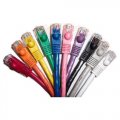What is the difference between cat 5e and cat6 cable?
If you’re researching the different types of twisted-pair copper cable used to transmit data in network and home theater applications, then it’s likely that you will repeatedly come across the terms Category 5e (CAT5e patch cables) and Category 6 (CAT6 patch cables). Organizations such as the Telecommunication Industry Association (TIA) and Electronic Industries Association (EIA) set specific product standards, and these guidelines have resulted in cables being classified into various categories based on their performance levels. Just in case you’re not too familiar with cabling terminology, we would like to provide you with a few straightforward definitions and statistics on these three common grades of network cable, to help you better choose the right one to fit your needs.
CAT5e: Cat 5e (which stands for Category 5, enhanced) cable goes along the same lines as basic Cat 5, except that it fulfills higher standards of data transmission. While Cat 5 is common in existing cabling systems, Category 5e has almost entirely replaced it in new installations. Cat 5e can handle data transfer at 1000 Mbps, is suitable for Gigabit Ethernet, and experiences much lower levels of near-end crosstalk (NEXT) than Cat 5.
CAT6: Of the three cable categories we’re discussing, Category 6 is the most advanced and provides the best performance. Just like Cat 5 and Cat 5e, Category 6 cable is typically made up of four twisted pairs of copper wire, but its capabilities far exceed those of other cable types because of one particular structural difference: a longitudinal separator. This separator isolates each of the four pairs of twisted wire from the others, which reduces crosstalk, allows for faster data transfer, and gives Category 6 cable twice the bandwidth of Cat 5! Cat 6 cable is ideal for supporting 10 Gigabit Ethernet, and is able to operate at up to 250 MHz. Since technology and standards are constantly evolving, Cat 6 is the wisest choice of cable when taking any possible future updates to your network into consideration. Not only is Category 6 cable future-safe, it is also backward-compatible with any previously-existing Cat 5 and Cat 5e cabling found in older installations
How to Differentiate Between Cat5e and Cat6 Patch Cords
The major difference between Cat5e and Cat6 is the quality of performance they provide. Cat5e is typically used for networks using 100 Mbit/s or a gigabit network, with performance of up to 100 MHz. For networks that can handle up to 250 MHz, you would want to make use of Cat6 cabling, as it offers more than twice the performance of a Cat5e. Although Cat6 may be able to handle greater data loads than Cat5e, it’s always best to use the proper patch cord to match the cabling in your building; it pays to find out what is already in use at your location before installing the network.
Are Cat5e and Cat6 Compatible?
You may be asking yourself ‘What if my building is set up to use Cat5e but all I have are Cat6 patch cords? Am I still able to use them?’ The answer to the question would be ‘Yes, you can!” As stated before, it’s preferential to match cable types; however, it is possible to mix and match Cat5e and Cat6 if necessary. If you’re unsure of the wiring of the building, you may also want to go with Cat6. To ensure maximum performance, you will want to use the best components possible all throughout the network.
Is it Possible to Patch Computers in Close Quarters?
When patching two computers in the same area, a special patch cord called a crossover will be needed to make the connection. A Crossover patch cord uses reversed pins on either end to ensure the connection of the two computers, and enable them to share data. If you need to patch more than two computers, a switch and a standard patch cord for each computer will be necessary. A switch acts as a cross section of incoming data, and directs it to the proper computer.
What are Shielded Patch Cords and Why They Are Used?
In most cases, unshielded patch cords are used in networking, but if your surroundings have strong radio signal interference, a shielded network system and patch cords will most likely be required. Shielded patch cords have a metal inner jacket protecting the 4 pairs, and a metal jacket covering the RJ45 modular plugs. Shielded patch cords are for only specific applications and are not compatible with unshielded network equipment
we also have many common connectors of fiber optics, if you need them, we can provide more details.

